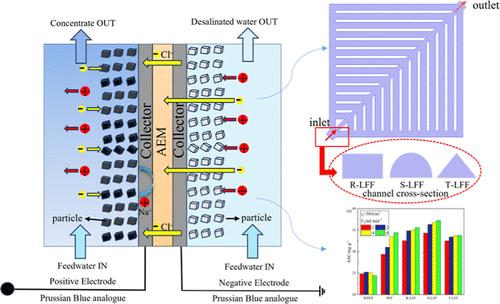当前位置:
X-MOL 学术
›
Ind. Eng. Chem. Res.
›
论文详情
Our official English website, www.x-mol.net, welcomes your feedback! (Note: you will need to create a separate account there.)
Enhanced Desalination Performance of Battery Electrode Deionization Based on the Optimized Design of Flow Channel Structure and Channel Section Reconstruction
Industrial & Engineering Chemistry Research ( IF 3.8 ) Pub Date : 2024-07-22 , DOI: 10.1021/acs.iecr.4c01284 Rui Liu 1 , Yu Tian 1 , Qiqi Zhang 1 , Yan Shen 1
Industrial & Engineering Chemistry Research ( IF 3.8 ) Pub Date : 2024-07-22 , DOI: 10.1021/acs.iecr.4c01284 Rui Liu 1 , Yu Tian 1 , Qiqi Zhang 1 , Yan Shen 1
Affiliation

|
Battery electrode deionization is an emerging technology for water desalination that cuts down on energy costs when desalinating different water streams. It uses electrochemical reactions under the action of an electric field to achieve salt removal. The removal of salt from water is achieved through an electrochemical reaction between ions and active compounds in this process. Traditional desalination cells typically employ a flat flow channel structure, which unfortunately results in a significant dead zone of flow. This paper proposes a new optimized design of a leaf-shaped flow field (FF). The development of a three-dimensional numerical model of the capacitive deionization and investigation of mass transfer behavior and cell performance for different channel cross sections is carried out. A uniformity factor has been introduced to describe the uniformity of Na+ ion concentration distribution and the desalination performance of the system is evaluated by salt adsorption capacity, average salt adsorption rate, and volumetric energy consumption (Ed). The results show that the FF design scheme can effectively reduce the dead zones in the flow channel, resulting in a more uniform and full utilization of the electrodes. The mass transfer behavior and cell performance of porous electrodes are affected by the channel cross-section. The use of a semicircular channel cross-section is the optimal design form. In addition, decreasing the charging current density and increasing the inlet flow rate can optimize the uniformity of the ion distribution in the flow channel and the uniform utilization of the electrodes, and reduce the volumetric energy consumption.
中文翻译:

基于流道结构优化设计和通道截面重构增强电池电极去离子脱盐性能
电池电极去离子是一种新兴的海水淡化技术,可在淡化不同水流时降低能源成本。它利用电场作用下的电化学反应来实现除盐。在此过程中,通过离子和活性化合物之间的电化学反应实现水中盐的去除。传统的海水淡化池通常采用扁平流道结构,不幸的是,这导致了明显的流动死区。本文提出了一种新的叶形流场(FF)优化设计。开发了电容去离子的三维数值模型,并研究了不同通道横截面的传质行为和电池性能。引入均匀度因子来描述Na + 离子浓度分布的均匀性,并通过盐吸附能力、平均盐吸附率和体积能耗(E d )。结果表明,FF设计方案可以有效减少流道死区,从而使电极的利用率更加均匀和充分。多孔电极的传质行为和电池性能受到通道横截面的影响。采用半圆形通道截面是最佳的设计形式。此外,降低充电电流密度和增加入口流量可以优化流道内离子分布的均匀性和电极的均匀利用率,并降低体积能耗。
更新日期:2024-07-22
中文翻译:

基于流道结构优化设计和通道截面重构增强电池电极去离子脱盐性能
电池电极去离子是一种新兴的海水淡化技术,可在淡化不同水流时降低能源成本。它利用电场作用下的电化学反应来实现除盐。在此过程中,通过离子和活性化合物之间的电化学反应实现水中盐的去除。传统的海水淡化池通常采用扁平流道结构,不幸的是,这导致了明显的流动死区。本文提出了一种新的叶形流场(FF)优化设计。开发了电容去离子的三维数值模型,并研究了不同通道横截面的传质行为和电池性能。引入均匀度因子来描述Na + 离子浓度分布的均匀性,并通过盐吸附能力、平均盐吸附率和体积能耗(E d )。结果表明,FF设计方案可以有效减少流道死区,从而使电极的利用率更加均匀和充分。多孔电极的传质行为和电池性能受到通道横截面的影响。采用半圆形通道截面是最佳的设计形式。此外,降低充电电流密度和增加入口流量可以优化流道内离子分布的均匀性和电极的均匀利用率,并降低体积能耗。












































 京公网安备 11010802027423号
京公网安备 11010802027423号